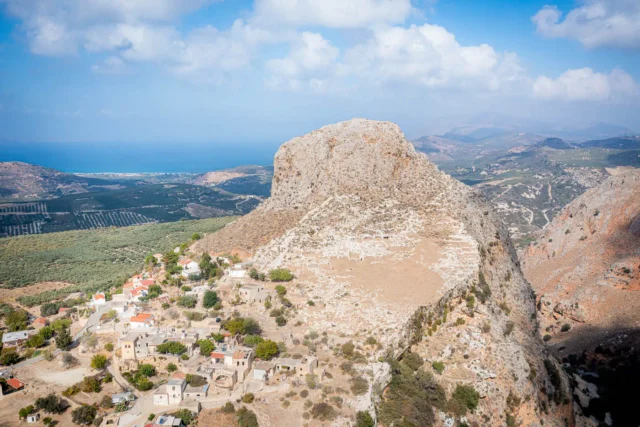Prases is a village situated in the White Mountains of Crete, within the municipality of Platanias, Chania regional unit. It lies at an altitude of 480 meters and is located approximately 31 kilometers southwest of Chania town. The village name, Prases, is derived from the Greek word “prasia,” meaning “greenery” or “nursery,” likely referring to the lush vegetation of the surrounding area.
Historical Overview
Venetian Era: Prases has a long history, with documented references dating back to the Venetian period of Cretan history (1204-1669). The village is mentioned in Venetian records as early as 1577 by Francesco Barozzi. The Venetian census of 1583, conducted by Castrofylaka, lists Prases (as “Prassea”) with 94 inhabitants and an obligation of 21 “aggarees” (a form of compulsory labor). Francesco Basilicata also mentions the village in 1630.
Ottoman Era: During the Ottoman period (1669-1898), Prases continued to be inhabited. The Egyptian census of 1834 lists “Prases” among other villages in the Lakki region. In 1842, Michael Chourmouzis mentions the village in his work “Cretica.” By 1881, Prases belonged to the municipality of Lakki and had an entirely Christian population of 263, according to the census. In the 1900 census, the population had grown to 329.
20th Century: In 1920, Prases became the seat of its own rural municipality. This status changed in 1925 when it was designated as the seat of a community, which it remained until the Kapodistrian administrative reform of 1997. At that time, Prases was incorporated into the municipality of Mousouri, which later became part of the municipality of Platanias.
World War II: Prases, like many Cretan villages, was impacted by the events of World War II. In 1941, during the German occupation, the village was the site of a tragic massacre. Following the Battle of Crete, the German administration, under General Bräuer, conducted investigations into alleged mutilations of German soldiers by Cretan civilians. In Prases, these investigations led to the execution of 698 individuals accused of being irregular fighters and 180 men executed under Article 4 of General Kurt Student’s order, which called for the “extermination of the male population” in specific areas.
Population Data
Year |
Population |
|---|---|
1900 |
329 |
1920 |
253 |
1928 |
259 |
1940 |
430 |
1951 |
267 |
1961 |
278 |
1971 |
209 |
1981 |
204 |
1991 |
|
2001 |
109 |
2011 |
76 |
2021 |
67 |
Points of Interest
Church of Agios Nikolaos: In the Askidia (or Skidia) neighborhood of Prases stands the church of Agios Nikolaos. This single-nave church with a vaulted roof features surviving frescoes and a partially preserved inscription commemorating its founder. Engravings within the church bear the dates 1513, 1527, and 1529, providing further evidence of its historical significance.
Traditional Architecture and Landscape: The original village of Prases developed along the course of a river that flows through the area. The newer part of the village has grown along the road. The houses are spread out, not concentrated in a dense center. The village square features traditional cafes that also serve food. Large plane trees grow along the riverbanks, and an old stone watermill stands near the river.
Askidia and the Gorge: Across from Prases lies the old Askidia neighborhood, known for its beautiful pine forest and the Byzantine church of Agios Georgios. Near the village, there is a gorge with a 5-kilometer hiking trail that offers scenic views of the surrounding landscape. The valley of Fasas, close to Prases, is home to a population of the endangered fern species Woodwardia radicans.
Chestnut Festival: Chestnuts and olive oil are the main agricultural products of Prases. Every October, the village holds a Chestnut Festival organized by the local cultural association. This festival is a lively Cretan celebration featuring traditional food, music, and dancing, with chestnuts prepared and served in a variety of ways.
Historical Trail: In 2021, a project was initiated to restore and enhance a historic trail that passes through Prases. This trail, known as the “Venetian Strata” or “Royal Strata,” once connected the Selino province with Chania town. The project, funded through the LEADER program, focuses on a 4.950-meter section of the trail within the Prases community. The restoration involves clearing vegetation, stabilizing retaining walls, and adding amenities such as a nature observatory, rest areas, recreational equipment, and signage. The project aims to highlight the natural beauty and biodiversity of the area while preserving its historical significance.
Village Key Points
- Historical References: Documented in Venetian records as early as 1577. Mentioned in various historical documents and censuses.
- Location: Chania regional unit, Crete, Greece. Approximately 31 km southwest of Chania town.
- Altitude: 480 meters above sea level.
- Historical Significance: Long history dating back to the Venetian period. Site of a World War II massacre. Features a historic trail and Byzantine-era church.
- Population: Population has declined in recent decades (see table above).
- Current Status: A small, quiet village with an agricultural economy, known for its natural beauty, chestnut production, and historical significance.
Access
Prases is 22.2 kilometers away from Palaiochora and 9.1 kilometers away from Vatolakkos





















There are no comments yet.